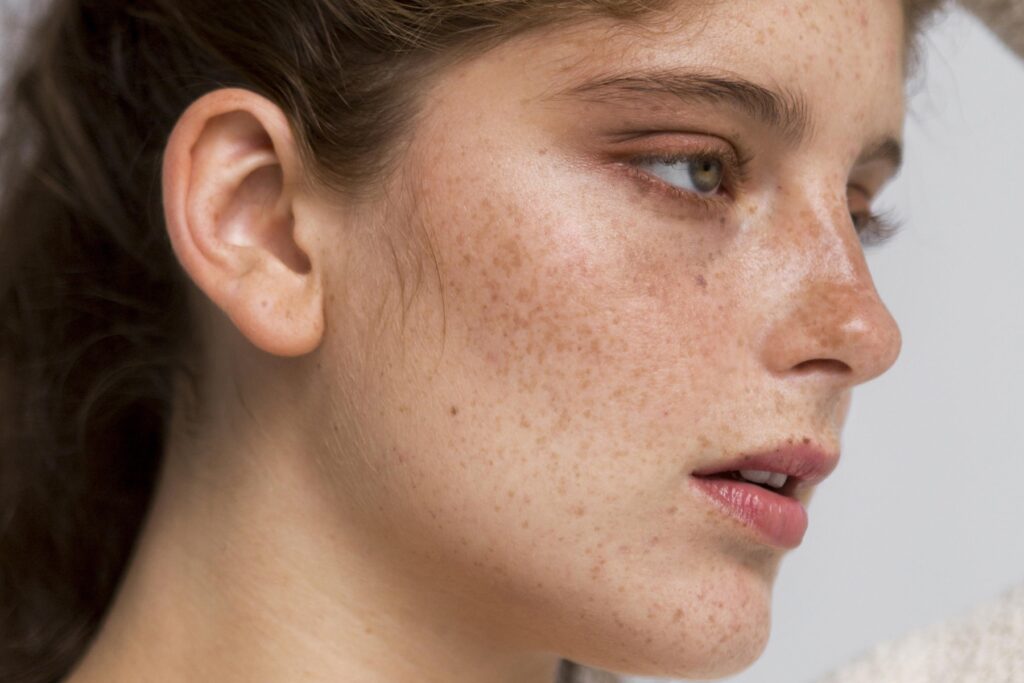- 70855-06939
- drponamrathod025@gmail.com
- Sandeep Vihar Society ,GH 79, Sect 20, Panchkula

Freckles Treatment
Freckles are small, flat, brown spots that typically appear on areas of the skin exposed to the sun, such as the face, shoulders, and arms. While harmless and often considered a charming feature, some individuals may wish to reduce or remove freckles for cosmetic reasons. Freckles form due to the uneven distribution of melanin in the skin, which can be influenced by genetics and sun exposure. Understanding the causes and exploring available treatments can help manage or minimize their appearance effectively.
Causes of Freckles
Freckles are primarily caused by:
- Genetics: A hereditary predisposition often determines susceptibility to freckles. Individuals with fair skin or red hair are more prone to freckling.
- Sun Exposure: Ultraviolet (UV) radiation from the sun stimulates melanin production, leading to the appearance of freckles.
- Age: Freckles can become more noticeable during childhood or with repeated sun exposure over time.
Freckles differ from other skin pigmentation issues like age spots or melasma, as they tend to lighten in winter and darken during summer.
Types of Freckle Treatments
There are several options for those seeking to reduce or remove freckles, ranging from natural remedies to advanced dermatological procedures.
1. Topical Treatments
Topical products can help lighten freckles over time:
- Skin-Lightening Creams: Over-the-counter or prescription creams containing hydroquinone, kojic acid, or azelaic acid can reduce pigmentation and even out skin tone.
- Retinoids: Vitamin A derivatives, like tretinoin, can improve skin cell turnover and reduce the appearance of freckles.
- Vitamin C Serums: Known for its antioxidant properties, vitamin C helps fade pigmentation and protects the skin from further sun damage.
2. Chemical Peels
Chemical peels involve applying an acidic solution to the skin to remove the top layer, promoting regeneration and reducing freckles. Peels with glycolic acid or trichloroacetic acid are commonly used for this purpose.
3. Laser Therapy
Laser treatments are one of the most effective methods for freckle removal. Lasers target the melanin in the freckles, breaking it down so the body can naturally eliminate the pigment. Commonly used lasers include Q-switched Nd:YAG and IPL (Intense Pulsed Light).
4. Microdermabrasion and Dermabrasion
These procedures involve exfoliating the skin’s surface layers to reduce pigmentation. Microdermabrasion is a gentler option, while dermabrasion is more intensive and suited for deeper pigmentation issues.
Preventive Measures
Preventing the formation of new freckles is as important as treating existing ones.
- Sun Protection: Regular use of a broad-spectrum sunscreen (SPF 30 or higher) is essential. Sunscreen protects the skin from UV rays that trigger melanin production.
- Protective Clothing: Wearing hats, sunglasses, and UV-protective clothing can limit sun exposure.
- Avoid Tanning Beds: Artificial UV rays can exacerbate freckling and other skin pigmentation issues.
Advancements in Freckle Treatments
Modern dermatology offers innovative solutions for treating freckles, ensuring safer, more effective, and quicker results.
1. Fractional Laser Treatments
Unlike traditional lasers, fractional lasers treat only a portion of the skin at a time, targeting freckles while preserving surrounding tissue. This results in faster healing and a natural, even skin tone.
2. Advanced IPL (Intense Pulsed Light)
Newer IPL devices provide customized wavelengths to address various skin types and pigmentation levels. These devices effectively target freckles and minimize the risk of irritation or uneven results.
3. Combination Treatments
Combining multiple treatments, such as chemical peels with laser therapy or topical creams with microdermabrasion, can enhance results and address other skin concerns like fine lines or uneven texture.
Post-Treatment Care
Post-treatment care plays a vital role in maintaining results and preventing the recurrence of freckles:
- Strict Sun Protection: Use sunscreen daily, even on cloudy days, and avoid prolonged sun exposure.
- Gentle Skincare: Avoid harsh exfoliants or active ingredients that could irritate the treated skin.
- Hydration: Keep the skin well-moisturized to support healing and maintain a healthy glow.
Menu
